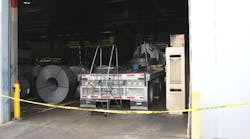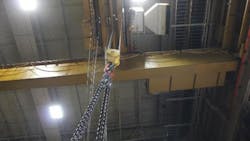On Oct. 26, 2015, an independent owner-operator, 46, had contracted with a trucking company to deliver and pick up a number of large steel coils, each about 5 ft. in diameter and weighing more than 15,000 lbs. He'd run the route before, and the coils were transported on a 100,000-lb. capacity flatbed trailer.
But in a tragic accident that day, the truck driver — a married father of two — was crushed to death under one of the coils when it tipped over during loading. These are the lessons learned and insight gleaned from an investigation into the incident.
What happened?
The Kentucky Fatality Assessment & Control Evaluation (FACE) program within the University of Kentucky's College of Public Health conducted the investigation. The FACE report noted that the truck driver arrived at 8:00 a.m. the morning the accident occurred.
The story unfolded in just 20 minutes. Working with a crane operator, the truck driver unloaded five steel coils and loaded another three for pickup, alternating between removing and loading on the heavy coils. It was with the third and final coil loaded onto the trailer that procedure and loading went wrong.
The coils were loaded with a 40-ton bridge crane moving along rails and girders with hanging chain slings. That last steel coil loaded hadn't yet been secured down, but the crane operator unhooked the sling that ran through the coil's eye. The operator retracted the crane with its remote, and the chains dragged through and caught on the coil.
It was enough to cause the coil to tip. Neither the crane operator nor the truck driver had maintained a clear line of sight of the 7.6-ton coil, according to the FACE program report, which then landed on the driver's lower back and legs.
The steel stamping company's internal emergency response personnel were called to the scene, and emergency medical services were called at 8:21 and arrived within six minutes, according to the FACE report, followed shortly by police. A coroner pronounced the truck driver dead at the scene.
What might've prevented this outcome?
The FACE program made procedural recommendations that could've helped avoid this fatal accident. In the first of those, heavy steel coils and similar cargo that can tip over should be secured before a bridge crane sling is detached from them.
"As the crane operator actuated the bridge crane to move away from the coil, the crane's sling became hung in the eye of the coil, causing it to become unstable and fall over onto the truck driver," the report authors wrote. "Had the coil been properly secured to the flatbed trailer prior to removing the crane’s sling, the coil may not have become unstable."
Also, the workers loading such cargo should maintain a clear line of sight of the cargo at all times, the FACE report recommended. The truck driver had his back turned to the steel coils and crane, according to the report, and the crane operator was walking away from the cargo and stepping down from the flatbed trailer when he retracted the crane.
Personnel should be restricted from the loading zone when a bridge crane is used to load such heavy cargo as in this case. That's because bridge cranes can be unpredictable: "Machines often malfunction, and sudden shifts of weight distribution and movement direction can cause cargo to become unstable, increasing the risk of injury," the FACE report cautioned. Workers should consider the loading zone in such an instance a danger zone.
Finally, after placing and securing a steel coil or similar cargo, the report recommended that loading zone personnel should be sure that crane slings are fully detached before the crane is moved away. "The sling used to attach the bridge crane to the steel coils was detached from the steel coil, but still left in the coil’s eye," the report noted. "As the crane operator actuated the controls of the crane, the sling became caught inside of the eye of the coil, causing the coil to become unstable and topple over."
The full report is available at http://www.mc.uky.edu/kiprc/face/reports/pdf/15KY063.pdf.




